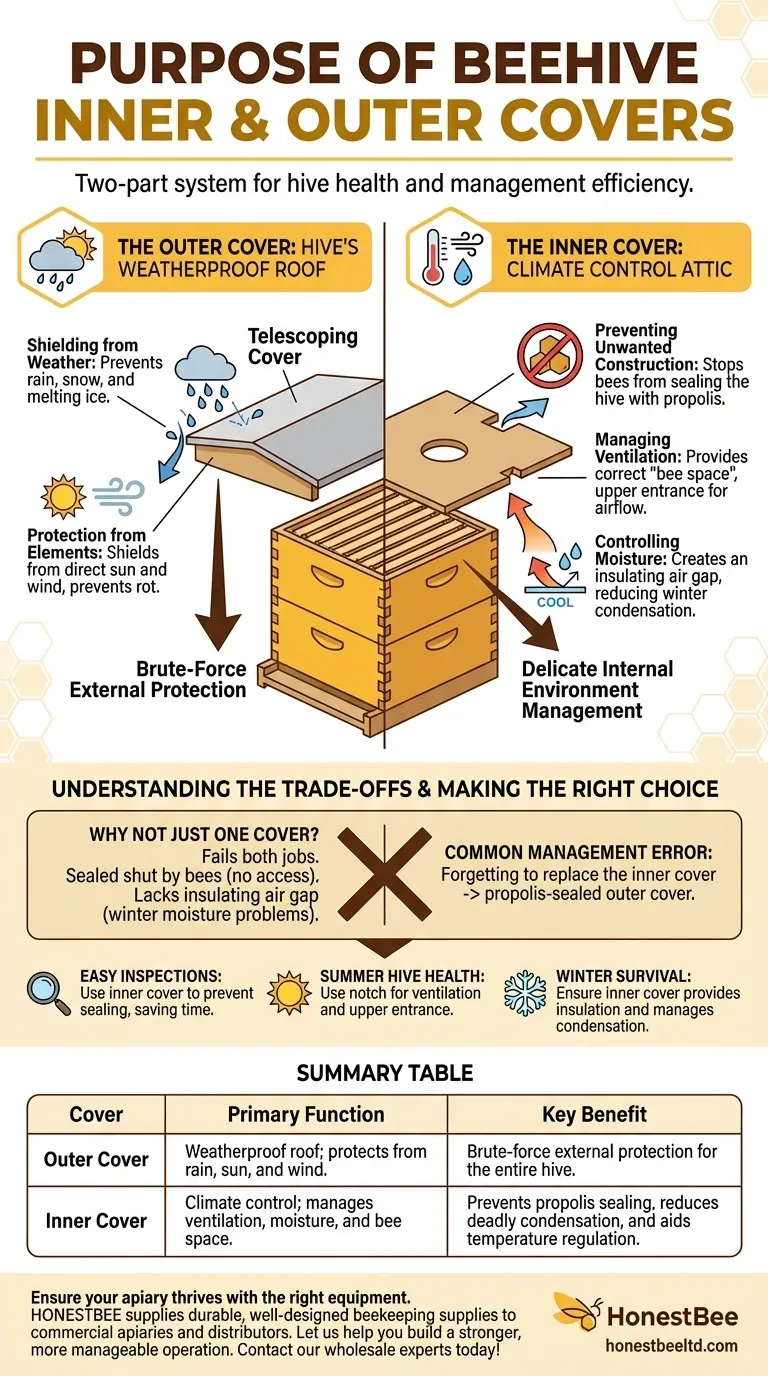In a standard beehive, the outer cover serves as the primary roof, protecting the colony from weather, while the inner cover acts as a crucial secondary barrier that manages the hive's internal climate and prevents the bees from sealing the hive shut. Together, they create a two-part system essential for both hive health and ease of management.
The most effective way to think about this system is to see the outer cover as the hive's weatherproof "roof" and the inner cover as its "attic." One provides brute-force protection from the elements, while the other skillfully manages the delicate internal environment of airflow, moisture, and access.

The Outer Cover: The Hive's First Line of Defense
The outer cover is the most straightforward component of the two. Its sole purpose is to provide robust, external protection for the entire colony.
Shielding from Weather
The most common design is a telescoping cover, which overhangs the top hive body. This design prevents rain, snow, and melting ice from dripping down the sides and into the hive's seams. It is the hive's primary defense against precipitation.
Protection from the Elements
Beyond rain, the outer cover shields the hive from direct, intense sunlight which can overheat the colony in the summer. It also provides a barrier against wind and protects the inner components from rot and decay.
The Inner Cover: The Climate Control System
While the outer cover handles the external world, the inner cover manages the much more delicate internal environment. Its role is surprisingly complex and vital for the colony's year-round health.
Preventing Unwanted Construction
Bees are instinctively driven to seal any large gaps with propolis (a resinous glue) and fill empty spaces with wax comb. Without an inner cover, they would firmly glue the outer cover directly to the top hive box, making inspections nearly impossible without damaging the hive structure.
Managing Ventilation
The inner cover provides the correct "bee space," a specific gap that discourages bees from building unwanted comb. Many inner covers also have a notched opening, which can be used as an upper entrance for the bees or as a crucial ventilation port to allow excess heat and moisture to escape.
Controlling Moisture and Condensation
This is perhaps the inner cover's most critical function, especially in winter. As the bee cluster generates heat, warm, moist air rises. When this air hits a cold outer cover, it condenses into water droplets, which can drip down onto the bees and kill them.
The inner cover creates a buffer zone. The air gap between the inner and outer covers provides insulation, keeping the inner cover's surface warmer and dramatically reducing the formation of this deadly condensation.
Understanding the Trade-offs
It's natural to ask why two separate covers are necessary. The answer lies in their distinct but complementary functions, which cannot be effectively combined into a single piece.
Why Not Just One Cover?
A single cover would fail at both jobs. It would be sealed shut by the bees, making hive access a destructive chore. Furthermore, it would lack the insulating air gap provided by the two-cover system, leading to severe moisture problems in the winter.
Common Management Errors
Forgetting to replace the inner cover after an inspection is a common mistake for new beekeepers. This forces you to pry a propolis-sealed outer cover off later, stressing the bees and risking damage to your equipment.
Making the Right Choice for Your Goal
Properly managing your hive covers is a simple action with a significant impact on your colony's well-being and your own beekeeping experience.
- If your primary focus is easy inspections: Always use an inner cover to prevent the outer cover from being sealed shut, saving you time and stress.
- If your primary focus is summer hive health: Use the inner cover's notch to provide an upper entrance and extra ventilation, helping to prevent the hive from overheating.
- If your primary focus is winter survival: Ensure the inner cover is in place to provide insulation and manage the deadly risk of internal condensation.
Understanding how these two covers work in tandem is fundamental to maintaining a healthy, productive, and manageable beehive.
Summary Table:
| Cover | Primary Function | Key Benefit |
|---|---|---|
| Outer Cover | Weatherproof roof; protects from rain, sun, and wind. | Brute-force external protection for the entire hive. |
| Inner Cover | Climate control; manages ventilation, moisture, and bee space. | Prevents propolis sealing, reduces deadly condensation, and aids temperature regulation. |
Ensure your apiary thrives with the right equipment. Proper hive covers are fundamental to colony health and beekeeping efficiency. At HONESTBEE, we supply durable, well-designed beekeeping supplies and equipment to commercial apiaries and distributors. Let us help you build a stronger, more manageable operation. Contact our wholesale experts today to discuss your needs!
Visual Guide

Related Products
- Telescopic Beehive Outer Cover Lid Roof with Galvanised Sheeting for Langstroth Hive and Beehive Outer Cover
- Inner Beehive Cover for Beekeeping Bee Hive Inner Cover
- Professional Insulated Winter Hive Wrap for Beekeeping
- Long Langstroth Style Horizontal Top Bar Hive for Wholesale
- HONESTBEE Advanced Ergonomic Stainless Steel Hive Tool for Beekeeping
People Also Ask
- Can bees enter from both sides of the outer cover? Master Seasonal Hive Management
- What is the purpose of a garden hive lid in beekeeping? Essential Protection for Your Colony's Health
- How do you install the Langstroth hive roof? A Step-by-Step Guide for a Healthy Colony
- What are the two primary lid styles for Langstroth style beehives? Choose the Right Protection for Your Hives
- How can garden hive lids be secured to prevent them from being blown off? | Reliable Methods for Apiary Protection



















